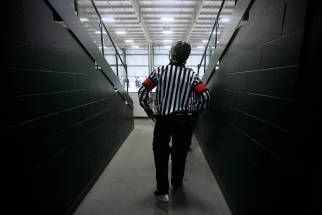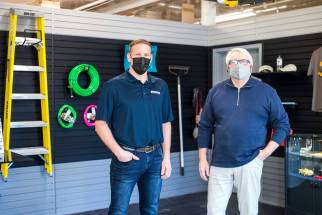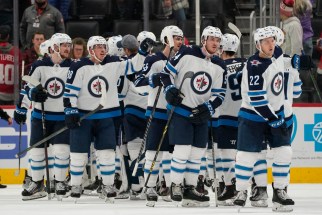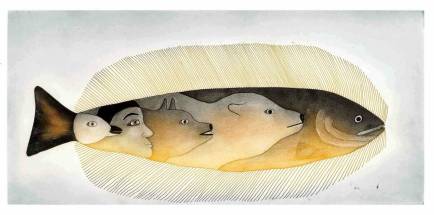Stripes not worth the strife Close up view of minor hockey’s ugly side demoralizing many young referees
Read this article for free:
or
Already have an account? Log in here »
To continue reading, please subscribe:
Monthly Digital Subscription
$0 for the first 4 weeks*
- Enjoy unlimited reading on winnipegfreepress.com
- Read the E-Edition, our digital replica newspaper
- Access News Break, our award-winning app
- Play interactive puzzles
*No charge for 4 weeks then price increases to the regular rate of $19.00 plus GST every four weeks. Offer available to new and qualified returning subscribers only. Cancel any time.
Monthly Digital Subscription
$4.75/week*
- Enjoy unlimited reading on winnipegfreepress.com
- Read the E-Edition, our digital replica newspaper
- Access News Break, our award-winning app
- Play interactive puzzles
*Billed as $19 plus GST every four weeks. Cancel any time.
To continue reading, please subscribe:
Add Free Press access to your Brandon Sun subscription for only an additional
$1 for the first 4 weeks*
*Your next subscription payment will increase by $1.00 and you will be charged $16.99 plus GST for four weeks. After four weeks, your payment will increase to $23.99 plus GST every four weeks.
Read unlimited articles for free today:
or
Already have an account? Log in here »
Hey there, time traveller!
This article was published 14/01/2022 (1427 days ago), so information in it may no longer be current.
Camille Forbes was officiating the second of four hockey games on a Saturday before Christmas when she paid the price for a bad hit.
It was a U15 A1 game, the youngest age group where body-checking is allowed. As a result, few players on the ice really know how to deliver a legal body check. More importantly, even fewer know how to take a legal body check.
Forbes, 24, was working the lines. At one point, a player who had just cleared the puck up the ice was drilled late by an opposing player, which sent him careening into Forbes who was holding her position along the boards. Without any time to avoid the collision, the helmet of the player being checked struck her in the chin, causing her head to snap back violently as she was sent flying into the boards.
“He probably didn’t even know I was there when he hit that other player,” Forbes said. “It was a pretty late hit and I really wasn’t expecting it, so I didn’t even have time to brace myself.”

Suffering from what hockey people would refer to as “concussion-like symptoms” — headache, back and neck spasms — Forbes was worried the incident would keep her off the ice for an extended period of time. Acknowledged as one of the busiest, up-and-coming referees in all of Winnipeg — she does 30 or more games every month in half a dozen different leagues, from basic minor hockey up to provincial U18 AAA and the Women’s Junior Hockey League — an injury would not only cost her a lot of money, but also a lot of game experience and exposure necessary to rise up the officiating ranks.
Fortunately, Forbes only had to stay off her skates for a few days. Still, it was a reminder that every time an official steps on the ice, they are taking an enormous risk sometimes for very little reward. In this case, the reward was $25.
“Everybody knows this is a hitting game, but they don’t realize those hits sometimes involve the refs,” Forbes said. “It can be dangerous out there.”
Official banter
Like most professions, hockey officiating has its own lexicon. Here are some commonly used terms that referees would like you to know:
● Up the middle/lineys: In the two official system, both officials are referred to as “referees.” In a three-official system, the head official works “up the middle” in concert with linespersons, often referred to as lineys.
The head official is largely responsible for calling penalties and is the only person who can stop play when a goal is scored.
Lineys patrol bluelines for offside, call icings and can stop play for a handful of incidents (puck out of play; net off its moorings) and infractions, including too many players on the ice. Lineys are also permitted to report to head officials at the first stoppage of play all four-minute penalties (head contact, kneeing, butt-ending, spearing), misconducts and major penalties.
Good head officials typically consult their lineys to get input on any serious call that could result in a player being ejected from the game.
Like most professions, hockey officiating has its own lexicon. Here are some commonly used terms that referees would like you to know:
● Up the middle/lineys: In the two official system, both officials are referred to as “referees.” In a three-official system, the head official works “up the middle” in concert with linespersons, often referred to as lineys.
The head official is largely responsible for calling penalties and is the only person who can stop play when a goal is scored.
Lineys patrol bluelines for offside, call icings and can stop play for a handful of incidents (puck out of play; net off its moorings) and infractions, including too many players on the ice. Lineys are also permitted to report to head officials at the first stoppage of play all four-minute penalties (head contact, kneeing, butt-ending, spearing), misconducts and major penalties.
Good head officials typically consult their lineys to get input on any serious call that could result in a player being ejected from the game.
● Game management: A highly misunderstood term misused by most players, coaches and even sports journalists and announcers.
Game management is the term referees use — not surprisingly — to describe overall management of the game to keep it fair and safe. It speaks to the discretion that is given to every referee to choose between several different penalties or groups of penalties to keep the game moving forward.
It is not, as some observers claim, a directive to referees to ensure that both teams receive the same number of penalties in a game.
Referees generally do not engage in make-up calls — assessing a penalty to even the short-handed situations for both teams — as much as the non-refereeing public believes. They do assess penalties to ensure infractions are fairly penalized.
In some instances, when multiple infractions are involved, referees are instructed to assess penalties in a way to ensure as few players as possible are in the box at any one time.
● Impact call: A close cousin to game management, the term impact call is used to help referees decide which penalties to call.
In most games, it is impossible to penalize every trip, hook, slash and bump; games would drag on forever. Referees are told to look out for penalties that have “impact” on the course of the game: a hook in the neutral zone that only slows a player down but does not result in a loss of possession might be overlooked; a hook on an attacking player in the slot, or one where a player loses possession of the puck, would be called.
It’s also why two players wrestling with each other behind the play might not be penalized; there is no specific infraction, no clear instigator and the behaviour is not affecting the course of play.
All violent or dangerous infractions — boarding, charging, roughing, aggressive slashes, cross checks, head contact — are considered impact calls and should be called regardless of their impact on the course of play.
● Game ejections: A game misconduct is not the only way a player can be ordered to leave a game. Under Hockey Canada rule 8.6, any player that receives three stick infractions (slashing, cross-checking, spearing, butt-ending, high-sticking) will be ejected.
The same goes for head-contact penalties; three or more penalties for accidentally or deliberately contacting a player’s head will result in a game ejection.
For the purpose of this rule, a double minor (head contact, spearing, butt-ending) is considered one penalty.
● Dropping the dime: When a player does something bad, but not bad enough to warrant an ejection from the game, they can be assessed a 10-minute misconduct. Players assessed this penalty will spend 10 minutes in the box on top of any other penalties they received.
If there is less than 10-minutes left, a dime can be used to remove player(s) from the game to prevent them from doing anything else worthy of a penalty.
Players who receive this misconduct are not subject to any additional suspension as a result, with one exception: any player receiving two 10-minute misconducts in the same game triggers an automatic game misconduct, which must be reported to league officials and can result in a further suspension.
● Using your voice: Referees are told from a young age that one of the most valuable tools they have at their disposal is their voices. “Using your voice” is important when announcing penalties, so that both teams know the call you are making.
Lineys also use their voices when waving off icings or off-sides, and to defuse potential “hot spots” — groups of players that could be a source of conflict.
Head officials will often loudly warn players not to freeze the puck along the boards, ease off cross-checks in front of the net and even congratulate players for making clean hits.
Using your voice lets the players know you are watching them and that you are engaged in the flow of play.
Hockey officiating is an essential part of the national game; without someone willing to don the stripes and oversee the games, we wouldn’t have hockey. However, few people outside the officiating community know what the job is like. It’s dangerous, cold, time-consuming, low-paying and, thanks to a culture of abuse that greets referees whenever they work a game, often demoralizing. And when you consider everything referees face on a game-by-game basis, perhaps it isn’t surprising there is a referee shortage in Canada right now.
Following the complete scrubbing of the 2020-21 season due to COVID-19, hockey returned last fall with the hope that modest social restrictions would be enough to keep the virus at bay and kids on the ice. Hardly anyone thought a shortage of on-ice officials would hamper a much-anticipated return to hockey. But that’s just what happened.
Hockey’s governing bodies from Newfoundland and Labrador to British Columbia found the number of registered officials was down between 20 and 50 per cent. This has led to sporadic game cancellations in most provinces and concerted public information campaigns by the sport’s governing bodies to recruit new officials.
Nationally, Hockey Canada registered about 33,000 on-ice officials in the 2019-20 hockey season, which was suspended in most provinces in the late winter of 2020 because of the pandemic. The following year, one in which hockey was cancelled, only 16,000 officials were registered. The national numbers for this year won’t be in until season’s end but in Manitoba, there are about 20 per cent fewer on-ice officials.
Peter Woods, executive director of Hockey Manitoba, said the province has roughly 1,300 registered officials this season, down from more than 1,500 just before the pandemic and well below the high water mark of about 1,900 which was recorded several years ago. However, Woods noted it’s really impossible within those numbers to tell how many officials make themselves available for youth hockey.

Community-based area-specific hockey associations all keep separate numbers on how many officials they have at their disposal but do not share that information with Hockey Manitoba, Woods said. And some of the those registered referees only officiated adult recreational hockey, so the exact size of the shortage at the youth hockey level is really unknown, he added.
Anecdotally, it appears the numbers are good at the elite level of hockey (AAA to junior hockey), which includes officials angling for a shot at international or professional hockey. And surprisingly, the numbers also appear strong at the entry level; youth as young as 12 years old can be certified to referee hockey and many area associations saw a strong turnout this year.
However, it is the middle contingent of the officiating ranks — older teens to adults who can officiate any level of youth hockey up to U18 — where the shortage seems to be most pronounced.
Paul Comte, a member of Hockey Manitoba’s Officials Development Committee and co-host of Ref Talk Radio, a Winnipeg podcast that provides an insider’s glimpse into officiating culture, said there is no clear indication about whether the drop in referee ranks this year is a temporary symptom of the pandemic, or part of another, more foundational problem.
“I’ve talked to a lot of people who said they took the break last year from the pandemic to re-evaluate their involvement in officiating,” said Comte, who referees games up to the junior hockey level. “And they’re telling me that after reflecting, hockey just wasn’t adding a lot to their lives.”
“I’ve talked to a lot of people who said they took the break last year from the pandemic to re-evaluate their involvement in officiating. And they’re telling me that after reflecting, hockey just wasn’t adding a lot to their lives.” – Paul Comte, co-host of Ref Talk Radio
Comte said most people in the hockey establishment — including national and provincial governing bodies — have been concerned for some time that officiating was waning in popularity for a variety of reasons, including the fact that it can be dangerous and involves a lot of conflict with parents, coaches and players.
“When you think about it and what we put ourselves through, there is a lot of downside to this job,” Comte said. “And after giving it up for a year, a lot of refs found out they just didn’t miss it as much as they thought they were going to.”
Mitchell Jeffrey, the head of Hockey Winnipeg Referee Development and author of How To Referee Hockey: It’s not Just About the Rule Book, has conducted several surveys through his website, wpgrefs.com, to find out where all the officials have gone. “What we found was during the pandemic when there was no hockey, a lot of younger referees simply found other things to do,” he said. “It didn’t seem like they were escaping something; they just wanted to do something else.”
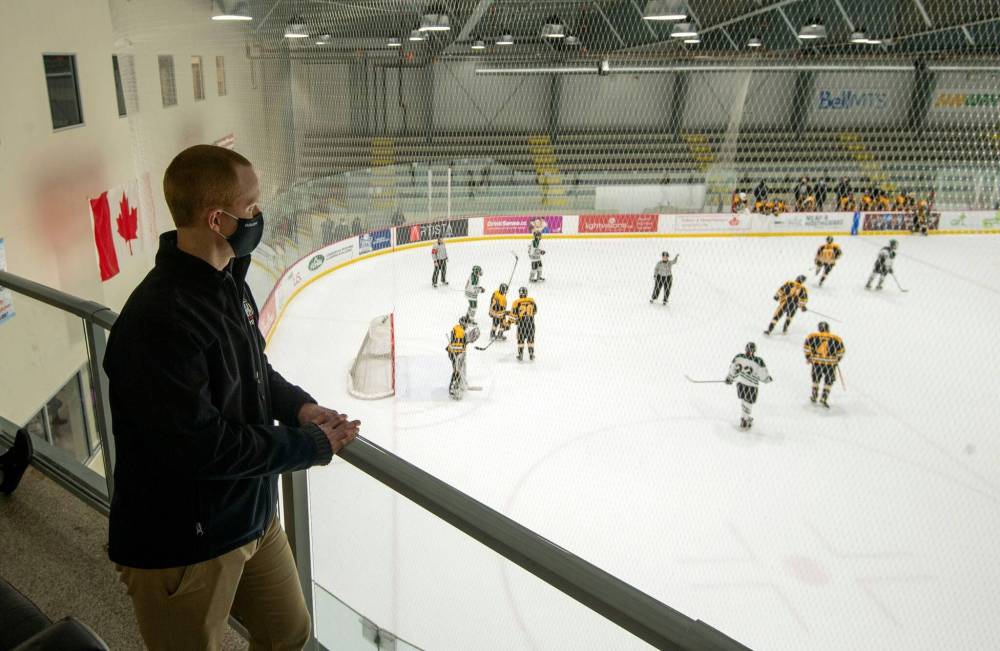
Still, Jeffrey said it’s impossible to get away from the reality that hockey officiating takes its toll.
“We go out on the ice to do our job, and people know we’re there, but we’re told that we cannot be the centre of attention. We have to maintain that approach even when people disrespect us or yell at us. We tell refs that you cannot yell back at people who are yelling at you. It’s a very tough job and it’s not for everyone.”
● ● ●
Luke Janus was just 15 years old when he had the worst experiencing of his young officiating career.
Two years ago, Janus was the head official in a U15 A1 game at Maples Arena when he assessed what refs call a “CFB” — otherwise known as a check from behind. In this instance, it was a two-minute minor penalty that carries an automatic game misconduct. Janus said that when he reported the call to the coach of the penalized player, the coach went off.
It was the second period, with lots of hockey left to play and Janus said the coach angrily demanded the call be changed to a minor boarding penalty, which would mean no game misconduct. Janus said he stuck to his guns and eventually had to stop talking to the coach and get back to the game.
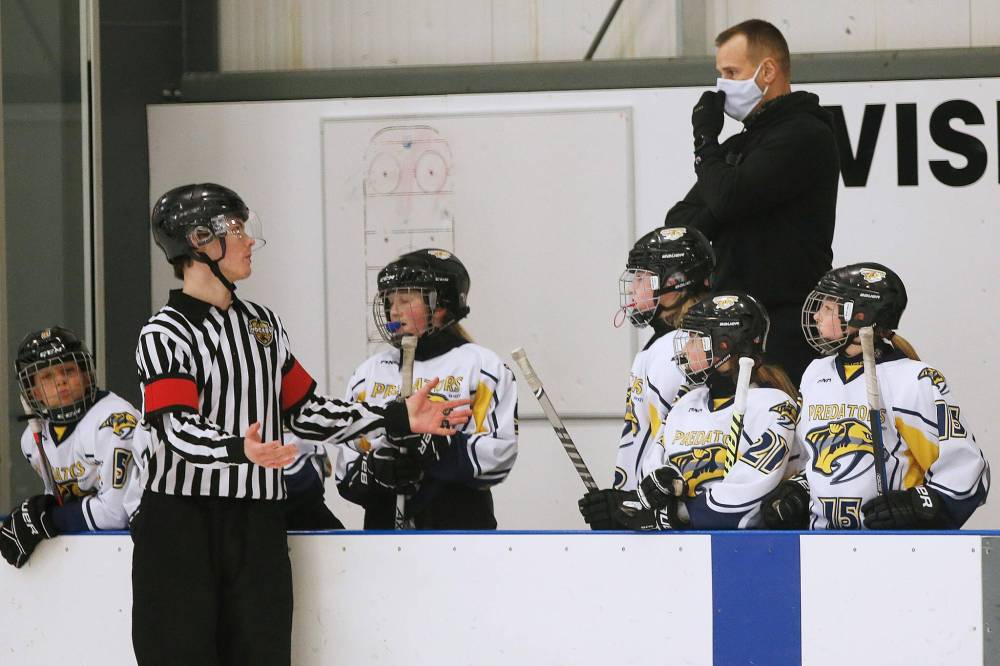
In the break between the second and third periods, the coach walked all the way around the rink from the player’s bench to the timekeepers box and started yelling at Janus that he was going to report this incident to the league and that “we would never ref another game.” Eventually, Janus was forced to throw the coach out and write him up for a gross misconduct, one of the most serious infractions in the rule book.
“It was a pretty traumatizing experience,” said Janus, now 17 and officiating up to the AAA level of hockey. “When I got home, I told my parents I didn’t want to referee anymore. It really rattled me.”
Fortunately, Janus was being mentored in his officiating career by Justin Johnson, a former referee-in-chief of Seven Oaks Minor Hockey who is now a linesman in both the AHL and NHL. “Justin told me not to take the whole thing too hard. A lot of coaches and players overreact in the heat of the moment and they forget that refs are humans, too.”
They also likely do not know that for most young referees, being threatened and insulted by adults is a painful right of passage in hockey officiating.
Listening to Janus’s story was painful for me, because it recalled many of the same experiences I had when I started refereeing in my early teens.
Ever been at a Winnipeg Jets hockey game and heard 14,000 people chant “Ref, you suck” with lusty enthusiasm?
I lived north of Toronto in a small town named Tottenham where there were few referees and — for those brave or stupid enough — nearly limitless opportunities to work games.
For five years, I worked games at every level of youth hockey. Just before going away to university, I started to do lines for the lower levels of junior hockey.
And then, I turned my back on the whole thing. Even after I moved to Winnipeg for work, I started playing hockey again but couldn’t quite muster the enthusiasm to get back involved in officiating. It was only many years later, after my own kids no longer needed me to coach their hockey teams, that I re-acquired a striped jersey and whistle and got back in the refereeing game.
At first, it was pure pleasure, a heady reminder of why I invested so much time doing this in my mid to late teens. If you love hockey, refereeing gives you the best seat in the house. In a word, it’s thrilling.
And then, slowly, I started to see the ugly side of youth hockey again. About a month after my return to officiating, I realized the relationship between hockey officials and others in and around the game had not evolved in the years I had been away from refereeing.

Now, I do more than 150 games every year. And, like most referees, in the safety of the referees’ dressing room, I share stories about the worst experiences I’ve had, entries in the all-time referee abuse hall of shame. Coaches hurling profanities, players lashing out in anger at opposing players, insults and threats from hyperactive parents.
This kind of behaviour doesn’t happen in every game but when it does, it tends to make an impression.
And really, you can see it at every level of hockey.
Ever been at a Winnipeg Jets hockey game and heard 14,000 people chant “Ref, you suck” with lusty enthusiasm? The sound of thousands of people hurling abuse at referees may seem appropriate at the highest levels of hockey, a world away from a youth game in a community arena. But the sentiment is exactly the same as the parents who beat their fists on the glass because they don’t like a call.
It’s time we faced up to an ugly reality: in this hockey-mad nation, we accept the abuse of on-ice officials as a God-given right, as much a part of the game as sticks, pucks and skates.
“Overall, disrespect in any form is not OK. Challenging a referee’s call is not OK.” – Dan Hanoomansingh, Hockey Canada’s manager of officiating
Over the decades, the hockey establishment has used different approaches to curb the abuse of officials. There have been public education campaigns. All coaches and at least one member of every hockey family have been asked to complete an online “Respect in Sports” course that discusses all forms of physical and mental abuse that can be a part of the game, including the abuse of officials.
And yet, even with all those efforts, it’s hard to find an official who honestly believes they are treated better now than they were years ago when they started officiating. That in part helped prompt Hockey Canada this past off-season to introduce a new section to their rule book — Section 11 Maltreatment — that is aimed at empowering officials to clamp down on abuse in all its forms.
Section 11 does not contain new rules, per se. But it does bring together all of the infractions and explanatory notes from across the rule book that have been introduced over the years to deal with unsportsmanlike conduct and abuse.

“If we look at the rules in Section 11, there is very little changed from the rules as they existed before,” said Dan Hanoomansingh, Hockey Canada’s manager of officiating. “The goal of creating a new section was to draw attention to it. In seminars with officials, the message was ‘look, we’ve always had these rules and we need to enforce them.’”
Section 11 is not, however, a zero-tolerance policy by Hockey Canada.
Hockey is an emotional game, said Hanoomansingh, and it would be counterproductive to introduce such tight restraints on behaviour that players and coaches were not allowed some leeway.
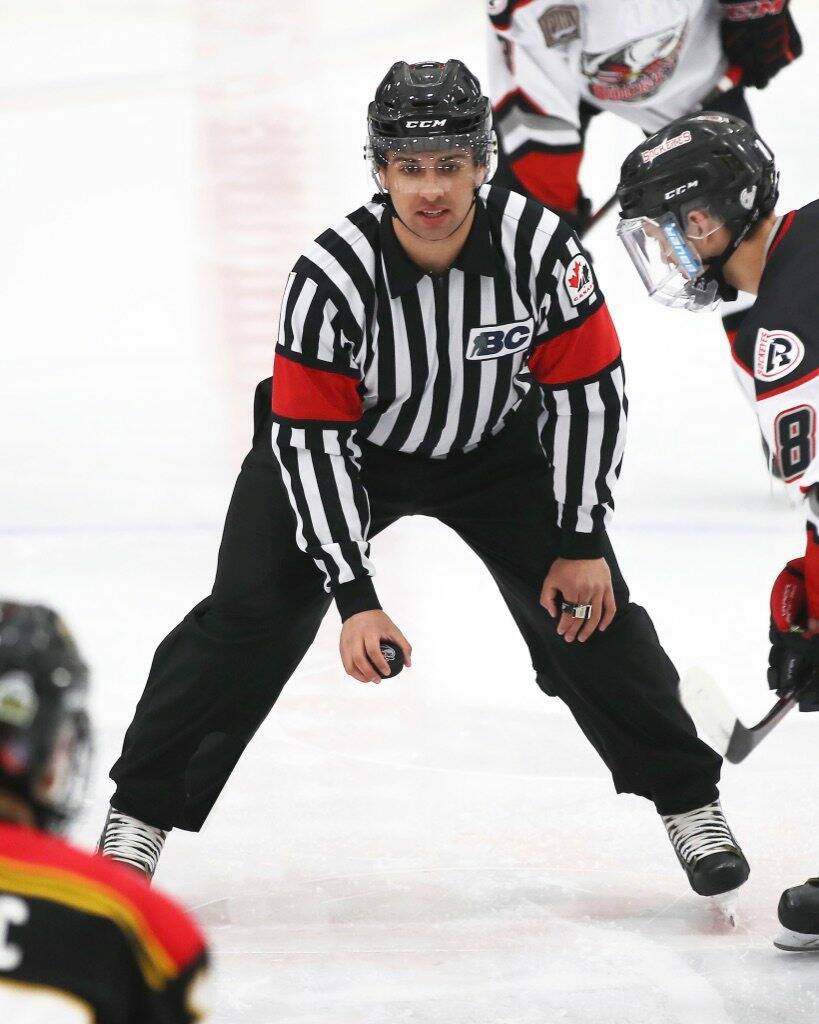
Rather than an attempt to take all emotion out of the game, Hanoomansingh said Hockey Canada is encouraging officials to use their discretion, and use verbal warnings, rather than penalties, to curb abusive behaviour.
One thing that will not be tolerated, he said, is any direct abuse of an official. “Overall, disrespect in any form is not OK. Challenging a referee’s call is not OK.”
Section 11 has left the hockey community scrambling to not only apply new standards, but also educate parents, players and coaches about those new standards. In short, while Hockey Canada did communicate the substance and intent of Section 11 to every referee in the country through the annual certification process, it’s evident to most referees at this point in the season that most people outside the officiating ranks had no idea about the new section and other important rule changes.
This year, for example, Hockey Canada made kneeing — when a player sticks out a leg to trip or upend an opposing player — a four-minute penalty to underline the inherent risk of injury associated with this type of play. It also encouraged referees to watch out for serious charging penalties — where a player takes more than two steps to load up for a big hit — and assess a five-minute major and game misconduct for any incident where an unsuspecting, vulnerable player is victimized by a charging infraction
George Mann, a retired Winnipeg Police Service officer and hockey referee for more than 30 years, said it’s quite clear coaches and players do not know about Section 11 or any of the other priority penalties Hockey Canada has identified for this season. That is not necessarily surprising; for reasons that are not entirely clear, Mann noted important rule changes have never been widely circulated to people outside the refereeing community.
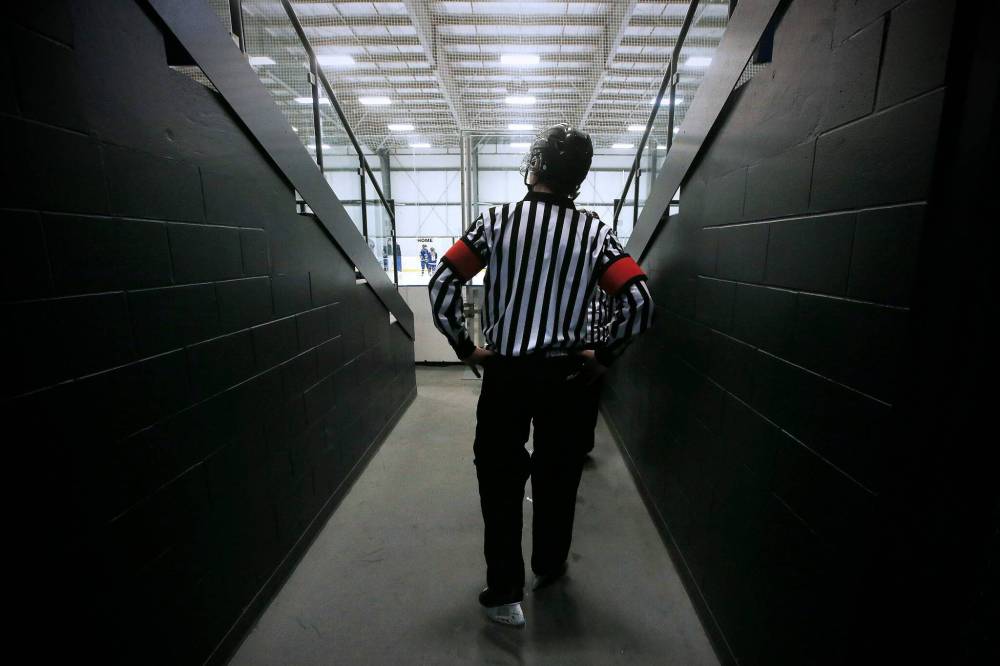
The result is that in most years on-ice officials not only have to assess these new penalties, they have to face the anger and frustration of players and coaches who are only learning about new rules as they are being penalized.
“When Hockey Canada creates something like Section 11 (maltreatment), there needs to be more work done to get the information out to the grassroots,” said Mann, who previously served as referee-in-chief for the River East Hockey Association. “It’s really hard to get people to change their actions if they don’t even know what the new rules are.”
Mann said some area associations in the city do make an effort to hold meetings for coaches to discuss rule changes, but often that does not happen until just prior to playoffs which does very little to support referees during the regular season. “I think the idea of all these rule changes is really good, but we really have to start doing some promotion,” Mann said.
● ● ●
Did you know that if a player picks up a discarded stick and throws it to another player who has lost their stick, two penalties must be assessed? The first penalty is two minutes for throwing a stick; the second penalty is also two minutes for illegally receiving a stick.
Welcome to the wonderful, imperfect and arcane world of the Hockey Canada rule book.
Only 165 pages long, the rule book is the bible for infractions, procedures and other issues of game management that guides on-ice officials in the commission of their duties. While huge tracts of the rule book are more or less self-explanatory, other sections are triumphs in semantic obfuscation. Put another way, the rule book can create more confusion than clarity.
Still, the basic rules of the game are quite easy to understand, and they are accessible, even for the non-referee. Hockey Canada makes its rule book available online for download and through a mobile device app. They are valuable resources because even the most experienced referees need to double-check the rule book.
Get your rules straight
Many fans, coaches and players who yell at referees do so because of a profound misunderstanding of the rules of hockey. Here are some rules that referees wish you knew better.
TOO MANY PLAYERS ON THE ICE
Line changes in youth hockey can be a source of mayhem, and often produce howls from coaches and fans largely because the rule is not well understood. Rule 2.5 (Change of Players) explains that a team can be assessed a two-minute bench minor if it has too many players on the ice. However, there are caveats:
“If in the course of making a substitution, either the player entering the game or the player leaving the game intentionally plays the puck with their stick, skates or hands or intentionally checks or makes any physical contact with an opposing player while the player respectively leaving or entering the game is actually on the ice, then the infraction of Too Many Players on the Ice shall be called.
Many fans, coaches and players who yell at referees do so because of a profound misunderstanding of the rules of hockey. Here are some rules that referees wish you knew better.
TOO MANY PLAYERS ON THE ICE
Line changes in youth hockey can be a source of mayhem, and often produce howls from coaches and fans largely because the rule is not well understood. Rule 2.5 (Change of Players) explains that a team can be assessed a two-minute bench minor if it has too many players on the ice. However, there are caveats:
“If in the course of making a substitution, either the player entering the game or the player leaving the game intentionally plays the puck with their stick, skates or hands or intentionally checks or makes any physical contact with an opposing player while the player respectively leaving or entering the game is actually on the ice, then the infraction of Too Many Players on the Ice shall be called.
“If in the course of substituting, either the player entering the play or the player retiring is struck by the puck accidentally, the play should not be stopped and no penalty shall be called.”
LATE HITS & INTERFERENCE
Hockey coaches still tell players to make sure they “finish their checks,” which is shorthand for “hit opposing players as often as you can, even after they have lost possession of the puck.” Most officials will tell you that late hits are a major source of concern and injury, as most players are vulnerable to unexpected hits after passing the puck away. Officials will also tell you that fans, coaches and players often protest penalty calls for late hits. Rule 7.3 (Interference):
“Regarding the finishing of a check, a player must make immediate contact with an opponent upon the release of the puck for that contact to be legal. Immediate contact can best be described as contact occurring within a maximum distance of an arm and stick length between the puck carrier and the player delivering the check.” At true game speed, that is a gap that is less than a second between releasing the puck and hit. In other words, immediately.
GOALTENDERS VISITING THE PLAYER’S BENCH IN BETWEEN WHISTLES
It’s not intuitive, but there is method behind the madness of the rule that prohibits goaltenders from visiting their own benches during a game for any reason, including to fix their equipment. According to rule 3.1 (Adjustment of equipment):
“If a goaltender goes to the players’ bench to adjust any equipment, they shall retire from the ice and their place shall be taken by the alternate goaltender and no warm-up will be permitted. However, this would only apply where an alternate goaltender is dressed. The alternate goaltender must remain in the game until play resumes. For a violation of this rule, a Minor penalty for Delay of Game shall be assessed.”
INJURED PLAYERS & STOPPAGE OF PLAY
One scenario that causes arenas to erupt in anger at officials is when a player is injured and the referee does not blow the whistle to stop play. However, according to Rule 2.6 (Injured players):
“When a player is injured so that they cannot continue play or go to their bench, the play shall not be stopped until the injured player’s team has secured possession and control of the puck. If the injured player’s team is in possession of the puck at the time of the injury, the play shall be stopped immediately unless their team is in scoring position, at which time the Referee shall allow the play to be completed.
“Note 1: Where there is suspicion that a player has sustained serious injury, any On-Ice Official may stop play immediately. When the Referee stops play due to a suspected injury and then notices that there is no injury, the ruling still applies. This is a judgement call and the player must leave the ice until play resumes.”
INJURED PLAYERS & MAJOR PENALTIES
For the most common infractions, referees are given the option to assess a minor, a major and a game misconduct or a match penalty. Typically, this allows the officials to use their discretion to determine if the degree of violence (five-minute major and a game misconduct) or intent to injure (match) is appropriate. However, officials are also reminded that if a player is inadvertently injured as a result of the infraction, “a Major penalty and a Game Misconduct penalty must be assessed.” What that means is that if a player hooks another player, and that player falls awkwardly into the boards and is injured, the minor penalty is automatically elevated to a major and game misconduct. Or, if a player is tripped and is injured crashing into the net afterwards, it must be called a major and a game misconduct.
HEAD CONTACT
One of the least understood rules governs head contact. According to Rule 6.5, “accidental” contact to a player’s head is a two-minute minor; a double-minor (4 minutes) is assessed to any player that deliberately contacts another player’s head, or based on the “degree of violence of impact.” Referees are also allowed to assess a five-minute major penalty and a game misconduct, or a match penalty and a game misconduct, for particularly violent blows to the head.
Here’s the real catch: even an otherwise legal body check that results in direct contact between a player’s shoulder and another player’s head must be penalized. “All contact above the shoulders (neck, face and head) is to be called Head Contact.”
Given all that, it’s a wonder the non-officiating community knows so little about the game.
Referees can tell you that the gross majority of in-game disputes are due to ignorance of the basic rules of the game. These disputes often fester and then trigger the moments of seismic anger and frustration that require officials to assess penalties for abuse and disrespectful maltreatment.
What’s even more odd is that even though coaches must be certified by Hockey Canada to work behind a bench, there has never been a unit in the curriculum on rules. Never.
Hanoomansingh of Hockey Canada acknowledged that more needs to be done to educate people about basic rules. “Somehow, we have normalized the idea that referees have to know the rules but coaches don’t necessarily need to know the rules to be able to coach. That’s something we have to address.”
Peter Woods said Hockey Manitoba has discussed the same issue on many occasions and it’s probably time to take action.
“This has been brought up more than a few times and I think it would be hugely beneficial for coaches to have more knowledge of the rules, and then pass it down to players and parents. More knowledge is always a good thing.”
Most officials would tell you that more knowledge of the rules would be a huge help. But along with that there must be more awareness that hockey officials do not have separate opportunities to practise their craft. While players may skate two or more hours of practice for every hour of game time, referees have to learn and practise procedures and skills in the heat of a game. And that means mistakes are going to be made.
Young referees are told to own their mistakes and learn from them, but that’s hard when a group of adults is raining insults and abuse down on you. Luke Janus said he often asks people who are critical of referees if they could briefly imagine what it’s like to be on the wrong end of all that abuse.
“I often say, ‘How would you feel if you messed up in front of all these people, and they were all yelling at you. Would you want to keep reffing? Would it make you better?’ I don’t think so.”
dan.lett@winnipegfreepress.com


Born and raised in and around Toronto, Dan Lett came to Winnipeg in 1986, less than a year out of journalism school with a lifelong dream to be a newspaper reporter.
Our newsroom depends on a growing audience of readers to power our journalism. If you are not a paid reader, please consider becoming a subscriber.
Our newsroom depends on its audience of readers to power our journalism. Thank you for your support.
History
Updated on Friday, January 14, 2022 10:08 PM CST: Corrects link for rulebook download



